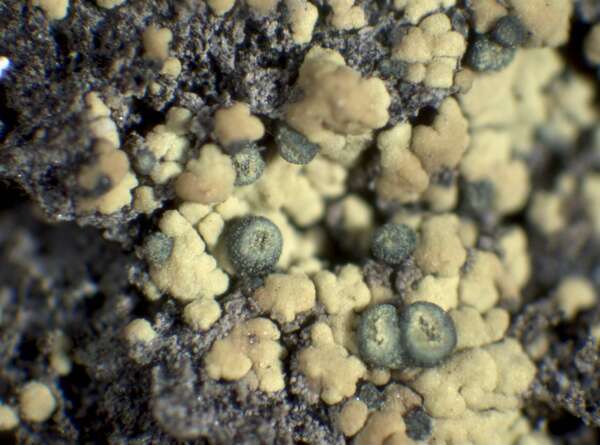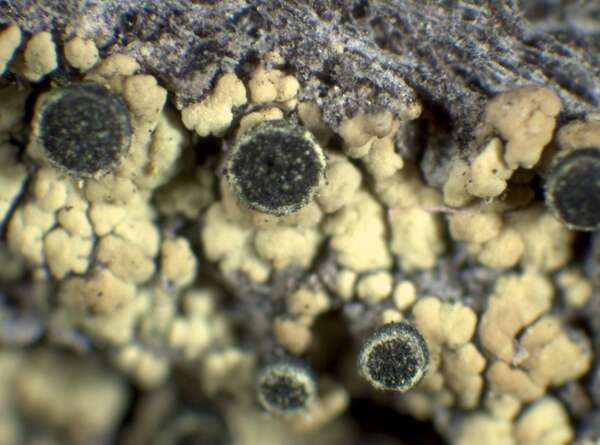Calicium lucidum (Th. Fr.) M. Prieto & Wedin
Fungal Divers, 2016 (MB 817534). Basionym: Trachylia lucida Th. Fr. - Öfvers. K. Vetensk.-Akad. Handl., 12: 18, 1855.
Synonyms: Acolium lucidum Rabenh.; Calicium virellum Nyl.; Cyphelium lucidum (Th. Fr.) Th. Fr.
Distribution: N - Ven (Puntillo & Puntillo 2009), TAA (Nascimbene & al. 2007b, Puntillo & Puntillo 2009), Lomb (Puntillo & Puntillo 2009).
Description: Thallus crustose, areolate to warted, the marginal areoles somewhat elongate, bright yellow-green to golden yellow. Cortex 9-13 µm thick, of minute, isodiametric, 2-3 µm wide cells; photobiont layer densely inspersed with minute yellow crystals. Apothecia 0.5-1 mm across, with a distinctly yellow-pruinose margin. Exciple 28-50 µm wide laterally, blackish brown, strongly thickened at base, of sclerotized, interwoven hyphae; mazaedium present, black; hypothecium dark, convex, up to 225 µm thick in the central part. Asci 8-spored, clavate, formed singly from hooked ascogenous hyphae, dissolving early, with uniseriately arranged ascospores. Ascospores 1-septate and constricted at septum, brown, ellipsoid, 17-22 x 8-10 µm, at first smooth but soon with a coarsely rimose-areolate surface. Photobiont chlorococcoid. Spot tests: thallus K-, C-, KC-, P-. Chemistry: thallus and yellow pruina of the apothecia with vulpinic acid. Note: a mainly boreal-montane, circumpolar species found on old conifers in humid, open, montane to subalpine forests with frequent fog. Rare in the Alps. It was included as “Regionally Extinct” in the Italian red list of epiphytic lichens (Nascimbene & al. 2013c).
Growth form: Crustose
Substrata: bark
Photobiont: green algae other than Trentepohlia
Reproductive strategy: mainly sexual
Commonnes-rarity: (info)
Alpine belt: absent
Subalpine belt: very rare
Oromediterranean belt: absent
Montane belt: extremely rare
Submediterranean belt: absent
Padanian area: absent
Humid submediterranean belt: absent
Humid mediterranean belt: absent
Dry mediterranean belt: absent

Predictive model
Herbarium samples
Growth form: Crustose
Substrata: bark
Photobiont: green algae other than Trentepohlia
Reproductive strategy: mainly sexual
Commonnes-rarity: (info)
Alpine belt: absent
Subalpine belt: very rare
Oromediterranean belt: absent
Montane belt: extremely rare
Submediterranean belt: absent
Padanian area: absent
Humid submediterranean belt: absent
Humid mediterranean belt: absent
Dry mediterranean belt: absent

Predictive model
| Herbarium samples |
 INDEX FUNGORUM
INDEX FUNGORUM
 GBIF
GBIF
 DOLICHENS
DOLICHENS




